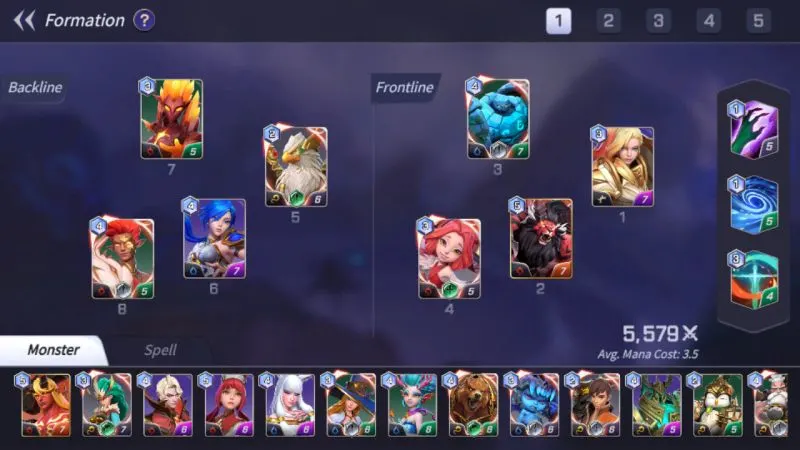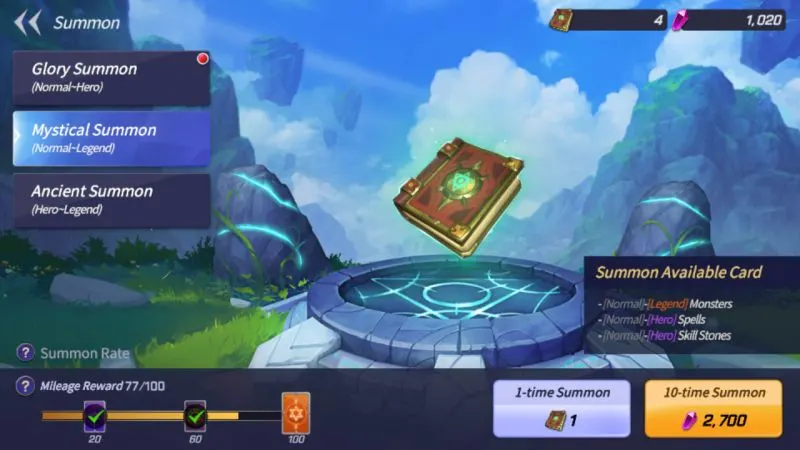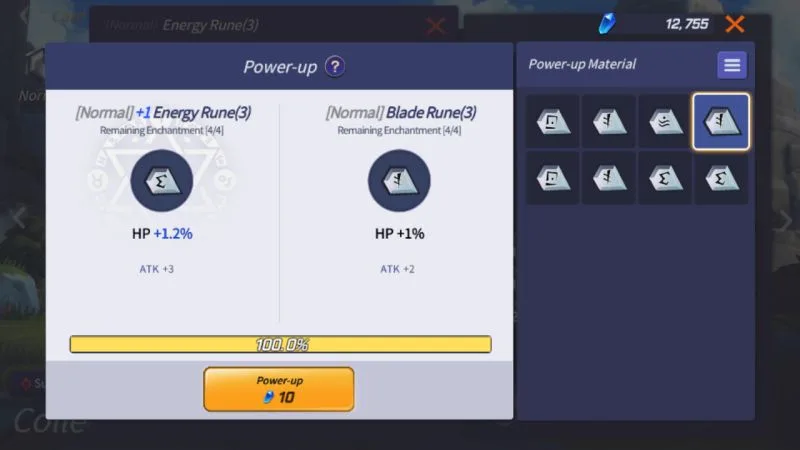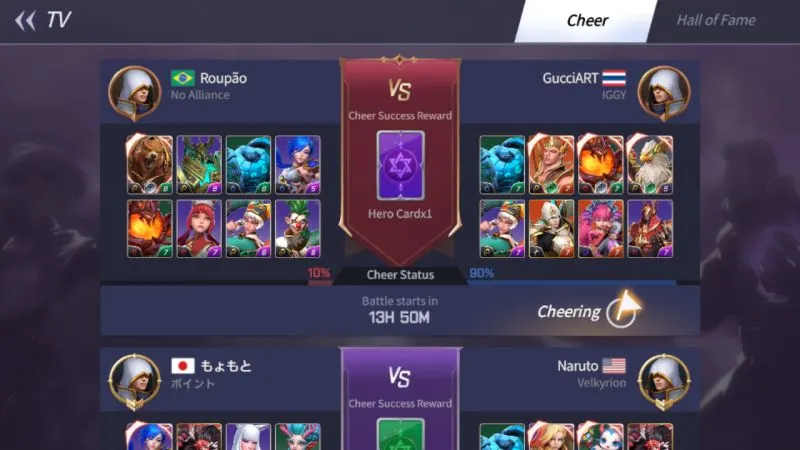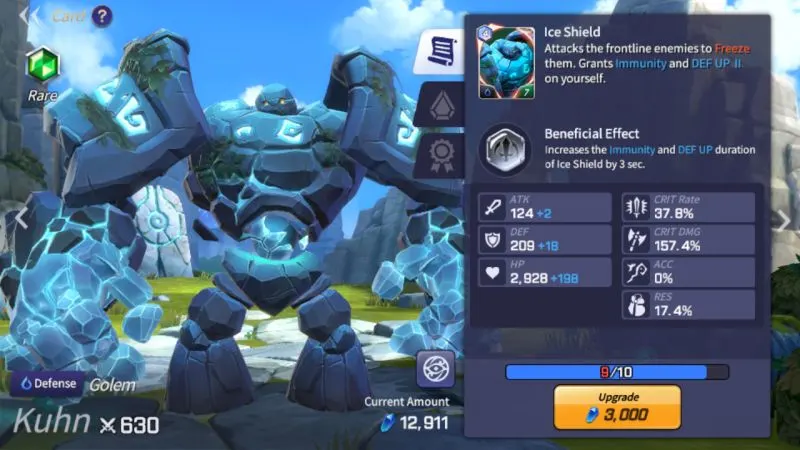Your thumb’s waiting on your tablet, twitching like a cowboy’s trigger finger. You’re waiting for the enemy’s first strike. You get impatient. Your mind shouts DRAW! You slam your thumb into the tablet, a command for your monsters to attack. You should have waited. The enemy counters sharply with a defensive unit, perhaps Woosa’s shield, perhaps Kuhn’s ice.
Either way, your attack fails, rendered impotent by the enemy’s quick thinking. A flurry of attacks and counters follow suit, a ragged yet oddly organized dance of combat. The match is far from over, but you get the inkling it won’t end well. This should be a familiar feeling to anyone who’s played and lost a couple of matches in Summoners War, Lost Centuria.
Summoners War: Lost Centuria is primarily a live-PVP real time card strategy game from Com2uS, on the surface much akin to Cookie Run: Kingdom in terms of gameplay, minus the kingdom-building stuff. You make a team, get into a fight with another team, and you tell your units to use their skills, timing them for maximum effect. There are a couple of massive differences though.
For one thing, PVP isn’t played with both users stuck with AI, but with both users actively commanding their units in the field. They wait for their cards to appear in the queue and their mana to charge, allowing for attacks. It comes with a Counter system, allowing your attacks to hit first if you use them while the enemy is doing their own attack.
Unit positioning is also highly important in Summoners War: Lost Centuria. You have a team of 8, and you get to determine who goes in the frontline and who goes in the rear line. This can result in formations that look crazy but work, such as using mid supports to tank attacks for the sake of damage dealers, or hiding a tank or lifestealer in the rear line as some form of battle insurance.
We compiled this guide as a means to help beginners get on their feet, especially since the counter system can seem counter-intuitive (It doesn’t stop the enemy from hitting you anyway!) until one learns how to use it properly. Learning these tactics here is a much less painful option compared to learning such tactics via having them used on you, after all! So stay with us and read our comprehensive Summoners War: Lost Centuria beginner’s guide below for tips, tricks and strategies to summon iconic monsters and dominate your enemies!
1. Counterattacks: Globally Offended
Counterattacks are weird, to say the least, but it’s the way it is so you don’t just try to counter without regard to what card you’re using. To use a counterattack, you must use a skill while an enemy is using their own skill. If you do so, your skill will hit first. The way they work though, they don’t actually stop the enemy from using said skill.
Even if your counterattack hits the current attacking enemy, a rarity in and of itself due to how enemy targeting works, their attack will still go through unless your counter kills them, or slaps some form of disable debuff on them.
Related: Summoners War: Lost Centuria Tier List: The Best Monsters and Spells in the Game
Knowing this, the best units to use for counterattacks are anyone who can do widespread stuns, freezes, or anything else that can stop an enemy’s attack in its tracks, like Kuhn’s freeze or Thrain’s random mass stun. Or anyone who can protect the current target of a skill (or everyone!) from damage, like Woosa or Chloe. That way, you render the enemy attack useless, or at least have a pretty good chance to.
2. Attack Formation
In the Formation tab, you can set up your team’s battle positions. Keep in mind that the further front you put someone, the more heat they’ll take since the game’s targeting always picks the frontmost guy, barring any character descriptions that state otherwise. The front and back line are also split between 4 characters each.
Units described as attacking the entire enemy frontline will not instantly attack the 4 furthest forward remaining enemy units. Instead, they will hit whatever’s left of the first 4 enemies, until they are all dead. Then and only then can they hit the 4 enemies in the rear line. This often results in attacks meant to be frontline AOE only hitting one or two guys halfway into a battle.
While it is a safe bet to post your tankiest guys up front, it might not always be the most galaxy-brained choice: A tank hiding in the frontmost part of the backline can help buy extra time after a fight’s gone bad, long enough for you to turn it around with your rear damage dealers. Not to mention some tanky characters also come with attacks that may be good enough that putting them in the backline is a viable option.
3. Specific Character, Specific Enemy, Specific Timing
In this game, certain characters and spells demand their attacks be timed accordingly to their role. Damage dealers are fine being used anytime, either to initiate an attack or to counter. Buffers are best used immediately to open an attack, especially if they’re placed somewhere in the rear line where they’re safer from being disabled.
Stun units and defensive units are best used to counterattack, examples being Woosa shielding the entire team right before a huge attack, or Kuhn throwing out a linewide freeze once anyone from the enemy frontline attacks. Debuff cleaners like the Transfer spell card are absolutely worthless as counterattacks, but are best used after the enemy actually hits you: You can’t remove a debuff if it isn’t there yet.
You have to keep an eye on which of your enemies are attacking too: If you see a mass disabler type like Kuhn waiting to freeze your frontline, then you can use rearliners to strike, safe from his counterfreezing. There is also the option to wait for the enemy to shoot first, then counter with one of your frontliners before they get frozen. Always keep an eye on your options, and remember when they are best used.
4. Stop Countering Me!
Say your opponent has a certain, incredibly irritating unit that is very good at ruining your moves with counterattacks. Like Woosa, who casts a status immunity and shield spell on everyone on his team. His shield is strong enough to absorb most attacks and render them ineffective, so he gets used to block attacks by countering them rather often. A good way to get around such a foe is to wait until your enemy fires first.
That way, you know he won’t be able to use such counter-happy units to counter, since you’re the one constantly countering! And if they decide to use such a unit early without countering, you can still hit them before they cast their spell, at best buying time for themselves after they’ve already taken the hit. Not to mention you can cast a healing or buff skill (Acceleration buffs for extra mana are a good choice here) when that happens so as not to waste your attack skills.
5. Cornered Beasts
When a unit dies, their card stops appearing in your queue. This is, for very obvious reasons like having fewer options or simply having less bodies on the field, bad. One way to take advantage of this though is to place your most devastating or lifesteal-happy attackers far in the rear. The more units you lose, the more likely those really nasty damage dealers in the back have their cards appear in the queue, until they’re the only ones left.
Provided enough mana (you may want to bring a buffer with a cheap Accelerate like Bernard), this can lead to a steady barrage of highly damaging skills turning the fight around. And if you aren’t losing any units and can’t make use of those skills, that just means the enemy isn’t killing you hard enough and they’re going to lose anyway.
On the flipside, this is also true of the enemy. If the enemy is down to their backline, press the advantage hard and be aggressive. Kick them in the teeth while they’re down, before they get back up and fight like a cornered beast.
6. Never Press Complete On A Wanted Poster Until It’s The Only Button Left
The fights in the Single Mode Wanted List have to be three starred to get the most out of them every day. Beat it at one star and you have the option to take the rewards given to you, but you won’t be able to go back in there again for a whole day. This is especially important since while the first two rewards are fairly paltry, the final three star reward is a small stipend of gems. You can’t afford to miss that!
7. Colored Letters
When viewing a character or spell description, particularly one involving buffs and debuffs, you can tap on colored letters to read the description of said buff or debuff. Make sure you do so, since a lot of them don’t have particularly descriptive names (Oblivion sounds like something ultra destructive, but all it does is disable passive skills, which not everyone has).
Of course, this also goes hand in hand with the fact you should take time to read the characters’ descriptions before using them! While their tier is normally a good indicator of how powerful they are, some low tier cards, like Bernard the Griffon, are used commonly for a reason. With Bernard’s being the fact they’re a cheap way to get loads of mana to roll over the enemy with.
8. Colored Squares
Speaking of buffs and debuffs, they appear as color coded squares on top of your units when they are afflicted or blessed by them. Red statuses are debuffs, which are obviously bad for you, unless you have a Transfer card in your hand to throw it back at them. Blue statuses are buffs, which are generally good for you, unless the enemy team has Soha ready to steal them. Purple statuses are less predictable:
They can be both buffs or debuffs, and they cannot be removed by any means other than whatever timer or counter they might have. You can’ t steal them from the enemy, or toss it back at them, or even clean them with some form of status dispel magic. Keep an eye out for these when deciding whether or not to use that Transfer card or Soha.
9. Summoning Discount
If you have summon books, great! You can summon new cards with them through the Mystical Summon gacha. If you don’t have books though, you can summon there with gems instead. You can summon however the heck you like if you’re using books, but never EVER do single summons with gems. Always go for the 10 roll, since you shave 300 gems off the total price as compared to doing 10 single rolls. Save your gems for the 10 roll discount!
10. Keep An Eye On Your Events And Dailies
As with a lot of mobile games, your daily rewards, achievements and event progress are your best source of resources. Always keep an eye on those little red notification circles, and never forget to take your rightfully earned free stuff. This goes double for limited time events, because you don’t want to miss those without actually claiming your rewards!
11. Elemental Rock Paper Scissors System
The game has an elemental rock paper scissors system, determining how often an attack hits for its greatest strength. Fire beats Wind, Wind beats Water, Water beats Fire. Light and Darkness both punch each other out in a game of rocket tag, while hitting poorly against themselves.
If your attack is weak against an element, then it will cause a Glancing Blow, which does very little damage. Meanwhile being strong against an element will cause a Crushing Blow, which hits much harder.
12. Generalist Or Specialized
When going into Duel Mode, go in with a plan but otherwise, keep your unit elements mostly generalist, unlike what you see in the image here. Since you cannot predict what kind of enemy team you’re gonna face, having all elements present on your team means you’re prepared for anything concerning the game’s elemental rock-paper-scissors.
In Single Mode though, while the AI enemy tends to cheat by having multiples of the same monsters or spells, it lets you know what you’re fighting. In that case, make a specialized team for killing the enemy’s specific composition, usually by matching the rock paper scissors with the enemy’s position: If the enemy has fire guys up front and water guys behind, put your water guys up front and some nature guys behind, so as the fight progresses the bad guys are dying ever so slightly faster from autoattacks.
13. Central Support Pillars
Support buffs stack up to a maximum of three levels. Knowing this, having two or so supports is a good number, since most supports give one or two levels of a certain buff. The rest, you’d need damage dealers or tanks since supports tend not to hit very hard, as in most games.
It might also help to put them around the middle of your formation, since you don’t want your final damage dealers to die first when everything goes wrong. Stinks having a support be your last unit in a fight, especially since damage dealers hiding in the very back are better at turning bad fights around.
14. Barrier Beatdown
Barrier Battle, located in Challenge Mode, is a fight that imposes upon the players a certain rule, called a Barrier, to spice things up. You’ve only got 3 losses before you have to wait for another 4 days for the next battle, which means it’s all about getting a win streak. The rewards are great though, so make sure you plan your team composition carefully, in accordance with the mode’s current rules. Like say, don’t bring any pure healers if the current rules say healing doesn’t work.
As for the cards to pick, worry less about their level and more about the team composition and how well equipped they are. Everyone is bumped to lv10, so the strength differences will mostly come from their Runes, skill stones, team synergy, and if your opponent by sheer dumb luck happens to bring a team that you counter. Oh, and whether or not you or the enemy times their attacks poorly!
15. Arena Tickets
Also located in Challenge Mode, Arena Mode is similar to Barrier mode in that you get three tries and everyone is bumped to level 10. It doesn’t have any additional rules though, so it’s purely a test of how well equipped your team is, your team’s ability to work together, and your timing skill.
Due to its 100 gem entrance fee, it’s best you go into this mode only when you’re already confident in your team, since you’re likely to get matched with people several thousand trophies above your rank. If you already paid for it though, you might as well play!
16. Only The Front Eats It
When you’re about to use a line AOE unit’s skill, take note of how many enemies are left in the enemy’s current frontline. If say, the enemy frontline has one guy left, the attack will only hit that one guy, wasting the AOE effect.
At that rate, it may be better to use a single target damage dealer instead if available, or wait for autoattacks to finish them off if they’re that close to dying. Kill that loner, then save the AOE guy for the poor backline suckers waiting behind him.
17. Overkill Is Overrated
Certain units are great for overkilling nearly dead foes, such as Hwa (who burns enemy mana on kill and targets whoever has the lowest HP anyway) and Ramagos (who heals himself upon kill).
Otherwise, if the target’s hp is so low they’re going to die from autoattacks soon or can be killed with an AOE attack that also hits their friends, overkilling them with a single target nuker is generally not efficient. The best time to overkill someone is if they’re the last enemy in a line, or if they’re an annoying, high-priority target like Woosa or anyone who can do map-wide AOE.
18. Keep None Safe
If you have any single unit that can deal damage to the entire field, for the love of all that is good, take them and put them somewhere in the backline or mid. The ability to damage the entire field, even with a relatively low-damage attack, stacks up across the whole match. When the enemy frontline collapses and you notice the enemy backline is already at half strength or near dead, then that guy’s done his job.
19. Mission Board Beatsticks
When setting up Mission Board teams, don’t just think about the elemental weaknesses and unit roles the board asks you to fill out. Think of the individual power level of each unit, since that also affects the success percentage of Mission Board requests.
Sometimes, it may be better to fill the third slot with someone carrying a high power level regardless of element, while having the first two fill the element requirements. Just check whichever set of units gets you the higher success percentage.
20. Rune Sets
In the Territory tab, you use Craft Building to get Runes, which can be equipped on monsters to make them stronger. When equipping Runes, do your best to have them match symbols with each other. Runes come with set bonuses, which are often much larger than what you would get from stuffing three different Runes into that guy’s slots, even if it’s three higher tier Runes vs three matching dinky little grey Runes.
At least you don’t have to match the color tiers either, just the symbols on the Runes. And just as you should match Runes to each other, you should match them to the hero: Give units Runes that play by their strengths and roles, as it will usually be their teammates that cover for their weaknesses anyway.
21. Powering Up Runes
Got a bunch of junk Runes from a crafting session? You can spend spare Runes to Power Up existing Runes, which means you should never sell the low tier ones. The way Power Ups work, they fill a bar, and once you cram enough spare Runes into the Rune you want to fill 100 percent, the Rune’s main stat powers up.
22. An Enchanting Day
Enchantment on the other hand adds a new stat to your Runes through the use of Enchantment Scrolls. You get these from doing the daily quests. In particular, Powering Up a Rune gets you two of these per day, and crafting a Rune does the same.
While it may be tempting to hoard these things until you level up and are able to craft better Runes, you should at least use some Enchantment Scrolls on your favorite unit’s Runes early on to get an advantage in early game. Not to mention lower tier Runes are cheaper to upgrade anyway.
23. Pre-Battle Inspection
Before a fight starts, too late for you to change your units, the enemy team is shown to you. Keep an eye on this. If an enemy beats you particularly badly, and you notice they aren’t grossly overlevelled or overequipped compared to you, take notes.
Perhaps their team might have better synergy than yours, maybe they timed their counters well, or they just countered your elements by complete accident. Totally understandable considering the random nature of matchmaking. Either way, watching your enemy’s team is a good way to learn about other cards, especially those you don’t own.
24. Cheerleading For Cards
On the lower right of the lobby, you’ll find a button that looks like a TV,. This lets you cheer on battles between players. You pay 100 Gems to cheer for a fight that pays a Hero tier card when your team wins, and 100 Mana Crystals for a Rare card. When Cheering for a team in the TV menu, a good bet would be to check the levels of the the team’s units, especially if you aren’t sure about both team’s composition.
Always come here not just to try and grab some cards, but also to check potential team comps: It might be a good idea to take notes from whoever wins the replay, especially if both teams were of roughly equal level. Oh and if the team you cheered for loses, at least you get a Normal card for your trouble.
25. Making Allies
In a multiplayer game of any sort, there is always a social aspect to keep in mind. Of particular note in Summoners War: Lost Centuria are Alliances. Joining an Alliance is always a good idea, considering being in one allows you to use the Alliance shop.
There’s also the option of getting cards from fellow players via the Alliance trading post. Not only does this allow you to complete your deck more predictably and easily, it lets you do the same for your fellow members!
26. Keep Your Cool… Aaaargh!
In this game, keeping your cool is important. You have to not just be quick on your thumb, but with your head and eyes too. It’s all too easy to just automatically keep your thumb on say, Kuhn, ready to freeze the enemy frontline if they attack.
Then you tap him when the enemy rearline attacks instead and waste his freeze, having failed to cancel an attack. Keep it cool, never give up, and don’t throw your tablet out the window!
Thanks for staying with us all the way here. If you have your own tips or tricks to share, don’t hesitate to discuss them down in the comment section below!



